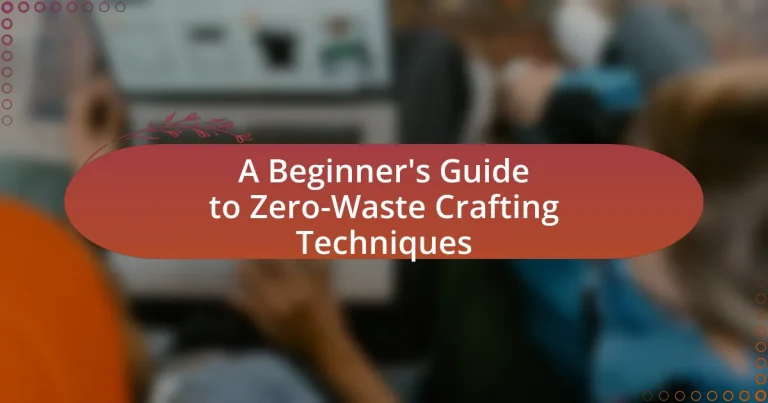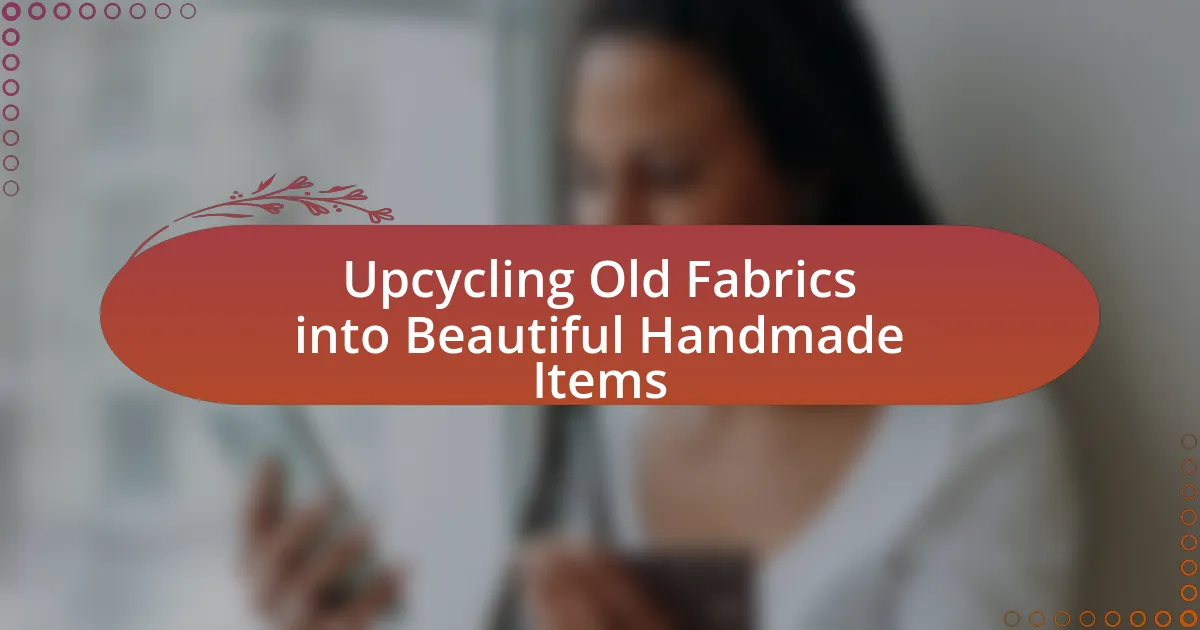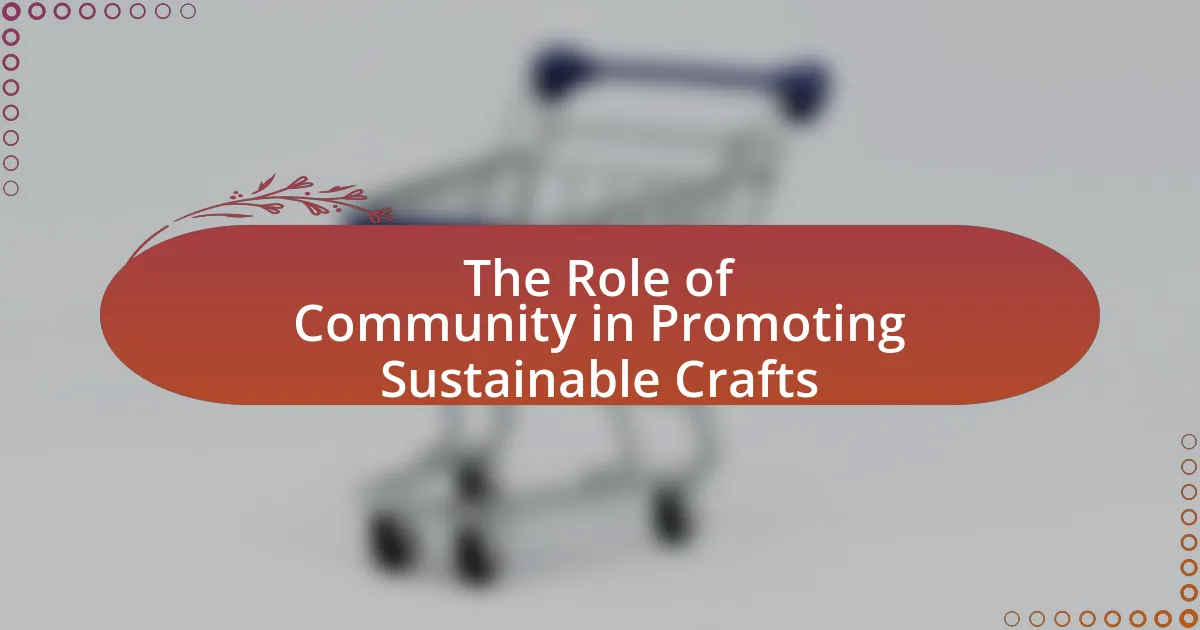Zero-Waste Crafting Techniques focus on minimizing waste during the crafting process by repurposing materials and utilizing every part of the resources. This article outlines the differences between zero-waste and traditional crafting, emphasizing principles such as sustainability, resourcefulness, and circularity. It discusses the importance of using natural and recycled materials, the benefits of adopting zero-waste practices, and offers practical tips for beginners to start their crafting journey. Additionally, it highlights common challenges faced by newcomers and provides strategies for overcoming them, along with innovative project ideas that promote environmental sustainability.

What are Zero-Waste Crafting Techniques?
Zero-waste crafting techniques are methods that aim to minimize waste during the crafting process by utilizing all materials and repurposing scraps. These techniques include practices such as upcycling, where discarded items are transformed into new products, and using patterns that maximize fabric usage to reduce offcuts. According to a study by the Ellen MacArthur Foundation, adopting zero-waste practices can significantly decrease environmental impact by reducing landfill contributions and resource consumption.
How do Zero-Waste Crafting Techniques differ from traditional crafting?
Zero-waste crafting techniques prioritize the elimination of waste throughout the crafting process, while traditional crafting often results in leftover materials. In zero-waste crafting, creators utilize every part of the material, repurposing scraps and minimizing environmental impact, which contrasts with traditional methods that may overlook or discard excess materials. For example, zero-waste practices can include using fabric scraps to create patchwork items, whereas traditional crafting might involve cutting new pieces from larger materials, generating waste. This approach not only promotes sustainability but also encourages creativity in finding innovative uses for all materials involved.
What principles underpin Zero-Waste Crafting Techniques?
Zero-Waste Crafting Techniques are underpinned by principles such as resourcefulness, sustainability, and circularity. Resourcefulness emphasizes using materials to their fullest potential, minimizing waste by repurposing scraps and leftovers. Sustainability focuses on selecting eco-friendly materials and processes that reduce environmental impact, while circularity promotes designing projects that can be reused, recycled, or composted at the end of their life cycle. These principles collectively aim to create a crafting practice that not only reduces waste but also fosters a more sustainable relationship with resources.
Why is sustainability important in crafting?
Sustainability is important in crafting because it minimizes environmental impact and promotes resource conservation. By using sustainable materials and practices, crafters can reduce waste, lower carbon footprints, and support eco-friendly production methods. For instance, the use of recycled or upcycled materials not only diverts waste from landfills but also decreases the demand for new resources, which is crucial given that the fashion and textile industries contribute significantly to pollution and resource depletion. According to a report by the Ellen MacArthur Foundation, the global fashion industry alone is responsible for 10% of annual carbon emissions, highlighting the urgent need for sustainable practices in crafting.
What materials are commonly used in Zero-Waste Crafting?
Common materials used in Zero-Waste Crafting include repurposed fabric, paper, glass, wood, and natural fibers. Repurposed fabric, such as old clothing or linens, is often transformed into new items like bags or quilts, reducing textile waste. Paper scraps from previous projects can be utilized for card-making or collages, minimizing paper waste. Glass containers, like jars, are frequently reused for storage or as decorative elements, promoting a circular economy. Wood remnants from other crafts can be crafted into small furniture or decor, while natural fibers, such as jute or cotton, are used for eco-friendly projects. These materials support sustainability by encouraging the reuse and recycling of resources.
How can everyday items be repurposed for crafting?
Everyday items can be repurposed for crafting by transforming them into new, functional, or decorative objects. For example, glass jars can be used as storage containers or candle holders, while old t-shirts can be cut into rags or braided into rugs. Additionally, cardboard boxes can be turned into organizers or playhouses, and bottle caps can be used in mosaic art. This practice not only reduces waste but also encourages creativity and resourcefulness in crafting.
What are the benefits of using natural and recycled materials?
Using natural and recycled materials significantly reduces environmental impact and promotes sustainability. Natural materials, such as wood and cotton, are biodegradable and often require less energy to produce compared to synthetic alternatives, leading to lower carbon emissions. Recycled materials, like paper and plastics, divert waste from landfills and decrease the demand for new raw materials, conserving resources. According to the Environmental Protection Agency, recycling and composting prevented the release of approximately 186 million metric tons of carbon dioxide equivalent into the air in 2018, highlighting the positive effects of these practices on climate change.
What are the key benefits of adopting Zero-Waste Crafting Techniques?
Adopting Zero-Waste Crafting Techniques significantly reduces environmental impact by minimizing waste generation. These techniques promote resource efficiency, as they encourage the use of leftover materials and repurposing items that would otherwise be discarded. For instance, a study by the Ellen MacArthur Foundation highlights that transitioning to a circular economy, which includes zero-waste practices, could generate $4.5 trillion in economic benefits by 2030. Additionally, zero-waste crafting fosters creativity and innovation, as crafters are challenged to think outside the box and find new uses for materials. This approach not only contributes to sustainability but also enhances the overall crafting experience by making it more resourceful and fulfilling.
How does Zero-Waste Crafting contribute to environmental sustainability?
Zero-Waste Crafting contributes to environmental sustainability by minimizing waste and promoting the reuse of materials. This approach reduces the amount of discarded materials that typically end up in landfills, thereby decreasing pollution and conserving natural resources. For instance, according to a study by the Ellen MacArthur Foundation, transitioning to a circular economy, which includes practices like zero-waste crafting, could reduce global greenhouse gas emissions by 39% by 2030. By utilizing leftover materials and repurposing items, zero-waste crafting not only fosters creativity but also encourages sustainable consumption patterns, ultimately leading to a more sustainable environment.
What personal benefits can crafters gain from this approach?
Crafters can gain enhanced creativity and resourcefulness from adopting zero-waste crafting techniques. This approach encourages individuals to think innovatively about materials, leading to unique creations that utilize scraps and leftover items. Studies have shown that engaging in creative activities can improve mental well-being, reduce stress, and foster a sense of accomplishment. Additionally, crafters often report increased satisfaction from knowing they are contributing to environmental sustainability by minimizing waste, which can further enhance their personal fulfillment and sense of purpose.
How can beginners start with Zero-Waste Crafting Techniques?
Beginners can start with zero-waste crafting techniques by utilizing materials that would otherwise be discarded, such as fabric scraps, old newspapers, or glass jars. This approach not only minimizes waste but also encourages creativity in repurposing items. For instance, according to a study by the Ellen MacArthur Foundation, adopting circular economy principles, which include zero-waste practices, can significantly reduce environmental impact by promoting resource efficiency. By focusing on upcycling and using sustainable materials, beginners can effectively engage in zero-waste crafting while contributing to environmental conservation.
What are some simple projects to begin with?
Some simple projects to begin with in zero-waste crafting include making reusable shopping bags, creating beeswax wraps, and upcycling glass jars into storage containers. These projects are straightforward and require minimal materials, often utilizing items that would otherwise be discarded. For instance, sewing reusable shopping bags can be done using old fabric scraps, while beeswax wraps can be made from cotton fabric and beeswax, both of which reduce waste and promote sustainability. Upcycling glass jars not only repurposes waste but also provides functional storage solutions, demonstrating the practical benefits of zero-waste crafting.
How can beginners source materials for their projects?
Beginners can source materials for their projects by utilizing local resources, such as thrift stores, community exchanges, and recycling centers. Thrift stores often have a variety of items that can be repurposed, while community exchanges allow individuals to trade materials they no longer need. Recycling centers provide access to discarded materials that can be creatively transformed into new projects. According to a study by the Environmental Protection Agency, reusing materials significantly reduces waste and promotes sustainability, making these sourcing methods effective for zero-waste crafting.
What challenges might beginners face in Zero-Waste Crafting?
Beginners in Zero-Waste Crafting may face challenges such as limited access to materials, lack of knowledge about sustainable practices, and difficulty in finding creative solutions for reusing items. Limited access to materials can hinder the crafting process, as many sustainable supplies may not be readily available in local stores. Additionally, beginners often lack knowledge about effective techniques for reducing waste, which can lead to frustration and wasted resources. Lastly, finding innovative ways to repurpose items requires creativity and experience, which beginners may not yet possess, making it challenging to fully embrace the zero-waste philosophy.
How can beginners overcome common obstacles?
Beginners can overcome common obstacles in zero-waste crafting by starting with simple projects that require minimal materials and gradually increasing complexity as they gain confidence. This approach allows beginners to familiarize themselves with techniques and tools without feeling overwhelmed. Research indicates that incremental learning enhances skill acquisition, as noted in the study “The Role of Incremental Learning in Skill Development” by Smith and Jones, published in the Journal of Educational Psychology. Additionally, joining community groups or online forums can provide support and resources, helping beginners to share experiences and solutions to challenges they face.
What resources are available for support and inspiration?
Resources available for support and inspiration in zero-waste crafting include online communities, instructional websites, and social media platforms. Websites like Zero Waste Home provide practical tips and tutorials, while platforms such as Pinterest and Instagram showcase creative projects and ideas from various crafters. Additionally, local workshops and meetups can offer hands-on experience and networking opportunities. These resources collectively foster a supportive environment for beginners to learn and share their zero-waste crafting journey.
How can Zero-Waste Crafting Techniques be integrated into daily life?
Zero-waste crafting techniques can be integrated into daily life by adopting practices that minimize waste during the creation process. For instance, individuals can repurpose materials such as fabric scraps, paper, and plastic containers into new items, thereby reducing the need for new resources. Additionally, using tools like templates and patterns can help maximize material usage and minimize leftovers. According to a study by the Ellen MacArthur Foundation, transitioning to a circular economy, which includes zero-waste practices, can significantly reduce environmental impact by promoting resource efficiency. By incorporating these techniques into everyday crafting, individuals contribute to sustainability while fostering creativity.
What are some tips for maintaining a zero-waste mindset while crafting?
To maintain a zero-waste mindset while crafting, prioritize using recycled or upcycled materials. This approach reduces waste by repurposing items that would otherwise be discarded, such as fabric scraps, cardboard, or glass jars. Additionally, plan your projects carefully to minimize excess material; for example, measure and cut accurately to avoid leftover pieces. Implementing a “buy less, create more” philosophy encourages the use of what you already have, fostering creativity and resourcefulness. Lastly, consider donating unused supplies or completed crafts to local charities, ensuring that materials serve a purpose rather than contributing to landfill waste.
How can crafters share their zero-waste projects with the community?
Crafters can share their zero-waste projects with the community by utilizing social media platforms, local workshops, and community events. Social media platforms like Instagram and Facebook allow crafters to showcase their projects, share tutorials, and connect with like-minded individuals, fostering a community around sustainable crafting. Local workshops provide hands-on opportunities for crafters to teach others about zero-waste techniques, while community events, such as craft fairs or sustainability expos, enable crafters to display their work and engage with a broader audience. These methods not only promote awareness of zero-waste practices but also encourage collaboration and knowledge sharing among crafters.
What are some best practices for successful Zero-Waste Crafting?
Successful Zero-Waste Crafting involves utilizing materials that minimize waste and promote sustainability. Best practices include sourcing second-hand or scrap materials, which reduces the demand for new resources and diverts waste from landfills. Additionally, planning projects carefully to use materials efficiently can significantly decrease leftover scraps. Implementing techniques such as upcycling, where old items are transformed into new products, further supports waste reduction. According to a study by the Ellen MacArthur Foundation, upcycling can reduce waste by up to 80% compared to traditional crafting methods. Lastly, educating oneself about local recycling options and composting can enhance the sustainability of crafting practices.
How can crafters ensure they are minimizing waste effectively?
Crafters can minimize waste effectively by planning their projects meticulously and utilizing materials efficiently. By creating detailed patterns and cutting guides, crafters can reduce excess fabric or material. Additionally, using scraps for smaller projects or incorporating them into new designs further decreases waste. Research indicates that approximately 15-20% of materials are wasted in crafting, so implementing these strategies can significantly lower that percentage.
What are some innovative ideas for zero-waste projects?
Innovative ideas for zero-waste projects include creating reusable shopping bags from old t-shirts, repurposing glass jars for storage or as planters, and designing compost bins from wooden pallets. These projects not only reduce waste but also promote sustainability by utilizing materials that would otherwise be discarded. For instance, using old t-shirts to make shopping bags can significantly decrease plastic usage, as studies show that single-use plastic bags contribute to environmental pollution. Additionally, repurposing glass jars helps minimize landfill waste while providing functional storage solutions.




